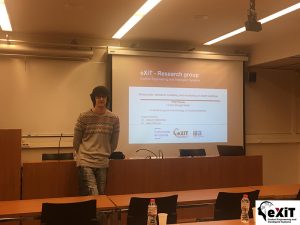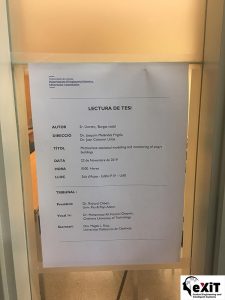Llorenç Burgas presented the PhD thesis
On 22 november 2019, Llorenç Burgas presented his PhD thesis: Multivariate statistical modelling and monitoring of smart buildings. Fantastic work!
The abstract:
In this modern world, energy has become an absolutely essential good in any developed society. As the technological and scientific advances that we enjoy today have been progressively adopted by society, we can see just how much they need and depend on the generation, storage and distribution of the various kinds of energy that are used nowadays, and which is why the demand for energy is constantly increasing.
Recently, serious concerns about the sustainability of the system have been raised because, unfortunately, not all of the energies we use are renewable. Furthermore, some of the energies in use nowadays can produce unwanted effects, such as, for example, the well-known CO2 emissions. As a result of such concerns, recently researchers have aimed their efforts at improving the uses we make of energy, improving the efficiency of the various processes linked to energy, and searching for cleaner and more efficient sources. The new regulations and directives, created by both the European Union and various governments around the world, are helping to move towards a more sustainable future. These new regulations encourage the use of renewable energies and try to encourage the improvement of energy uses. This thesis focusses on the uses of the various energies found in buildings and, in particular, controlling and monitoring
The lack of supervision or control of energy use has often been the cause of many energy losses. These losses are often caused by the complexity that monitoring all the possible uses of the conceivable types of energy requires. Even if we look at this problem only within the framework of buildings, there is clearly a lack of tools. In fact, not having enough versatile and powerful tools has led to mismatches in the multiple uses that are made of the huge amount of energy that we have at our disposal.
In order to reduce mismatches between real and expected consumption, this thesis explores the use of PCA (Principal Component Analysis) as a modelling tool for buildings. PCA is a statistical technique that allows complex systems to be modelled, and, subsequently, to monitor them to detect abnormal behaviours with respect to the conditions initially modelled. The work in this thesis includes adapting PCA to take full advantage of its potential in buildings. Such adaption is also verified by applying it to various use cases.
This thesis has been divided into tasks in an attempt to obtain a new methodology and tools with which to monitor buildings. The results obtained as these tasks were carried out, have resulted in three publications that have allowed thesis to be presented as a compendium of articles. In each of the publications, the following contributions have been made to the state of the art.
The first publication, takes as its initial point, a variant of PCA, MPCA (Multiway Principal Components Analysis) or Unfold-PCA. This variant of PCA allows batch processes to be analysed. In order to adapt them to the monitoring of buildings, this publication defines the two types of redundancy that we can find in buildings i.e., redundancy in time patterns (daily, weekly, seasonal, annual) and redundancy in physical spaces (room, apartment, plant, building). Considering these redundancies and assimilating them to the temporary redundancy of the batch processes, it is possible to obtain new ways of modelling buildings or parts of buildings, by considering the building as a whole and not as a set of independent systems.
The second publication, takes the first publication as its starting point and builds on the concept of the two types of redundancy being useful for modelling. The second publication defines the concept of the granular system. A granular system, in our case a building, is a system that has one or several redundancies in time (granularity) and/or variables/structure (modularity). In order to allow PCA, or other data-mining techniques that need a two-dimensional input, to take advantage of this inherent peculiarity, the data is mathematically defined using a fold and unfold technique (the way of organizing the data in N-dimensional arrays) that allows the structured data required to achieve a model that captures the desired behaviours to be obtained.
The third publication, which has been sent to a magazine, describes the implementation of the tools and methods developed in this thesis as web services included in a web application. This web application allows online PCA models to be used with the historical data of buildings. It also allows, when new data is available, the pre-existent models to be used for monitoring purposes. This tool is integrated into the European project HIT2GAP’s platform platform as an external module. This module allows users who are not experts in PCA, to carry out control and detection tasks using the previously created models. These models can be created with the same online tool by users expert in PCA modelling.
While this thesis was being undertaken, and and as part of the publications, the correct functioning of the methodology was verified using real data from various buildings. In short, the data used came from three different buildings (both architecturally and in terms of uses and available technical solutions) provided by: the Barcelona Patronat de l’Habitatge, the buildings on the Montilivi campus of the University of Girona and the AHU (Air Handling Unit) of the Alice Perry Building of the National University of Ireland Galway. In fact, the collaboration with the NUI Galway allowed us to have three-month internship and also to request the mention of international doctorate for this thesis.






